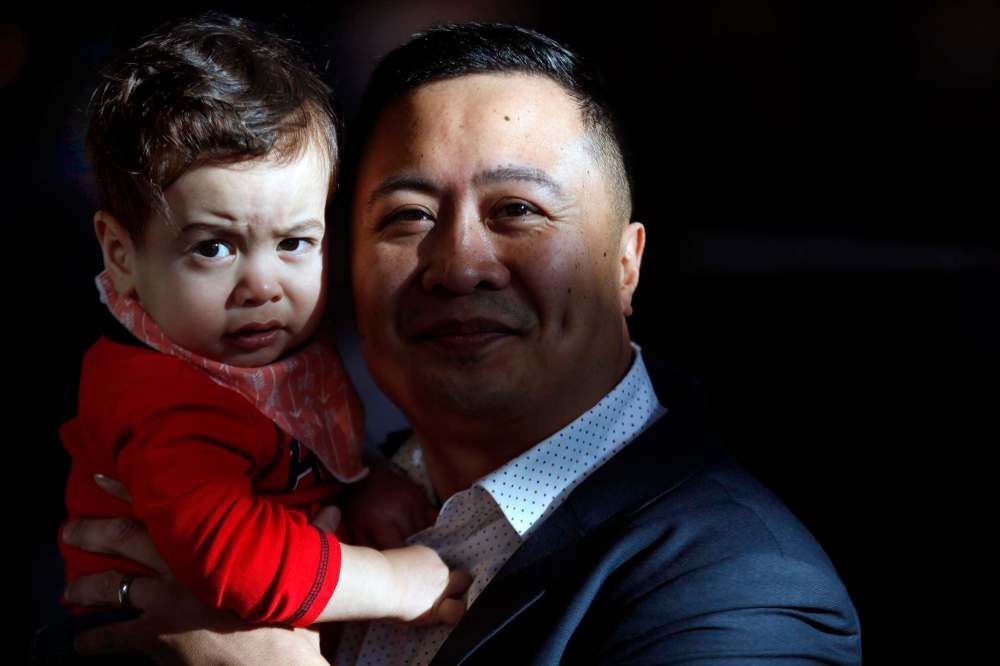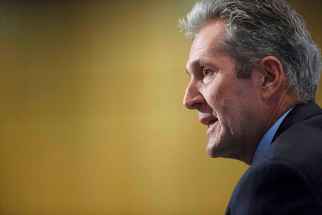Fathers’ day More Canadian families are taking advantage of shared parental leave
Read this article for free:
or
Already have an account? Log in here »
To continue reading, please subscribe:
Monthly Digital Subscription
$0 for the first 4 weeks*
- Enjoy unlimited reading on winnipegfreepress.com
- Read the E-Edition, our digital replica newspaper
- Access News Break, our award-winning app
- Play interactive puzzles
*No charge for 4 weeks then price increases to the regular rate of $19.00 plus GST every four weeks. Offer available to new and qualified returning subscribers only. Cancel any time.
Monthly Digital Subscription
$4.75/week*
- Enjoy unlimited reading on winnipegfreepress.com
- Read the E-Edition, our digital replica newspaper
- Access News Break, our award-winning app
- Play interactive puzzles
*Billed as $19 plus GST every four weeks. Cancel any time.
To continue reading, please subscribe:
Add Free Press access to your Brandon Sun subscription for only an additional
$1 for the first 4 weeks*
*Your next subscription payment will increase by $1.00 and you will be charged $16.99 plus GST for four weeks. After four weeks, your payment will increase to $23.99 plus GST every four weeks.
Read unlimited articles for free today:
or
Already have an account? Log in here »
Hey there, time traveller!
This article was published 21/03/2019 (2461 days ago), so information in it may no longer be current.
When people find out Jason Carkner is currently on parental leave, the response is almost always surprise.
“Like 90 per cent of the time,” says Carkner in the dining room of the Wolseley home he shares with his wife, Michelle, and their smiley 10-month-old daughter, June, who is taking down a bowl of oatmeal like a champ.

But the Carkners’ choice is actually reflective of a shift in this country when it comes to parental leave. They are two of the more than 32,000 Canadian parents who have opted for the extended 18-month parental leave since it was made available in December 2017. And, as of this week, eligible parents who wish to share their leave as the Carkners have will be able to access even more time.
On Sunday, the federal government rolled out its “use-it-or-lose-it” parental sharing benefit. Parents, including same-sex and adoptive, who opt for the standard 12-month parental leave will now get five additional weeks of leave, or eight additional weeks under the extended 18-month leave. In order to access the extra weeks, parents must agree to share the time away from work to take care of their baby, and must be eligible for Employment Insurance.
Child-care duties are still disproportionately shouldered by women; according to the federal government, women represented 85 per cent of all parental benefit claims filed in 2016 to 2017. One of the goals of the benefit, which was unveiled in the 2018 federal budget, is to improve gender equity when it comes to raising kids, in part by encouraging dads, like Jason Carkner, to take parental leave. (A note here on terminology: while a full leave to take care of a baby is often colloquially referred to as “mat leave”, especially when a mom takes it, maternity leave technically refers to a 15-week period after giving birth.)
Dads taking time away from work to focus on child care is just one part of the puzzle, however. To tackle the topic of fathers and parental leave is also to tease apart a Gordian knot of societal expectations and deeply ingrained gender roles — holdover ideas that mom is the nurturer and caregiver while dad is the breadwinner and provider. As families become more diverse and more women participate in the workforce, those roles are becoming less gendered, but society can be slow to catch up.
Carkner recalls a recent conversation he had with a couple who also has kids. “When the guy learned that I was going to be off for nine months, he was like, ‘Oh wow, enjoy your time off.’ The woman piped in and said, ‘Don’t let anyone tell you parental leave is a vacation,’ and he kind of rolled his eyes playfully and said he didn’t mean it like that. But I think he did mean it exactly like that.”

“I’m generally a pretty progressive person and a lot of my friends are too, so I’m in a bubble in a lot of ways,” says Travis Tomchuk, who just returned to work in February after an eight-month parental leave with his twin boys, Anton and Émile. “But there might be a colleague at work who, you’re telling him you’re going on this eight-month leave to take care of your twins and, he’s not saying it, but he’s kind of looking at you like, ‘Why the hell would you want to do that?’
“But some of the guys I play soccer with, the older guys, the guys who have 10 years on me, seem kind of interested in it. I started thinking, ‘I wonder if these guys would have taken an option if A) they had it or B) they felt they could do it without taking a lot of stick from their friends and family.’ ”
Tomchuk, who is in his mid-40s, and his partner Meghan decided to split their parental leave because it made sense for their family financially and Meghan, like Michelle Carkner, was eager to return to her career. “Someone Meghan knows expressed surprise that she was back at work so quickly and asked her who was taking care of the kids,” he says.
Tomchuk, meanwhile, was looking forward to changing gears.
“I was pretty excited to go on leave last June,” he says. “In a lot of ways it was like a vacation from work. It was just doing something different. Obviously, I had to make sure these two guys were fed, had their naps, and were clean and all that stuff, but it was also still my time. Plus, we’re fortunate that both our parents live relatively close to the city and were able to help.”
Tomchuk also had a front-row seat for all the milestones he might have missed had he been working the whole time. “It’s super great to see them change and be more aware of each other,” he says. “It was really fascinating watching them develop.” In fact, his experience was so positive, he regrets not taking time off when his oldest son, Darius, was born in 2014.

Not wanting to miss out on that formative first year of life was also a big motivator for Paul Lacap, who just returned from a parental leave with his now-15-month-old son Nathaniel. He decided to temporarily take the off-ramp from his busy career — he’s vice chair of Assiniboine Credit Union and a director at the University of Manitoba — and take care of his son, who was born two weeks after the 18-month leave was made available.
“In terms of looking back on my life and the things I’d remember, I probably won’t remember the meetings that I missed, but the first year of the life of your son? That’s something that goes by so quickly,” he says. “While I was going through it, sitting on those really long afternoons where he wouldn’t stop crying, I’d think, ‘You’re going to remember this years from now and think back on it warmly, so just relax.’”
All the dads interviewed for this story mentioned having a newfound appreciation for their partners and mothers in general. They described new-parent feelings often considred the sole domain of moms: the long days, making it all work financially, maintaining a sense of identity, the social isolation.
For men who have decided to become full-time fathers — like Sam Hagenlocher, 33, who is currently at home with his two-year-old daughter, Julia, while his wife Robin pursues her career as a clinical psychologist — those feelings can be compounded.
“I think one of the challenges for stay at home dads — and I speak just through this singular lens — is that you feel alienated, even more so than mothers do, because society hasn’t come along,” he says. “The stigma is still there. Every day I’m out with Julia and the inevitable comment is, ‘Oh, daddy’s having a day with his daughter!’ or ‘We’re on vacation!’
“Your biggest concern, on a selfish level, is how much this is going to hurt your worth on the open market to have these gaps in the resumé.”
Encouragingly, men like Hagenlocher are no longer statistical outliers. According to StatsCan, stay-at-home fathers accounted for about one in 10 of all Canadian families with a stay-at-home parent in 2015. In 1976, that number was about one in 70.

!function(e,t,s,i){var n=”InfogramEmbeds”,o=e.getElementsByTagName(“script”)[0],d=/^http:/.test(e.location)?”http:”:”https:”;if(/^/{2}/.test(i)&&(i=d+i),window[n]&&window[n].initialized)window[n].process&&window[n].process();else if(!e.getElementById(s)){var r=e.createElement(“script”);r.async=1,r.id=s,r.src=i,o.parentNode.insertBefore(r,o)}}(document,0,”infogram-async”,”https://e.infogram.com/js/dist/embed-loader-min.js”);
“It’s been very hard, but I think in the long run, it’s worth it,” Hagenlocher says of his own experience. “I’ve seen the kind of bond that you can create with a child when you’re always there for them, and they’re flourishing in their own right because they’re secure that you’re there.”
It’s worth noting that shared parental leave — or having a parent at home full time — doesn’t work for all families. “Not everyone is going to be in this position where they can take a pay cut to go on parental leave,” Tomchuk says. “I got about 80 per cent of my salary because our collective bargaining agreement has it enshrined that we get a top-up on top of EI, but not everyone is in that situation, which totally sucks.”
As for the extra weeks, he says, “If you’re not getting more money, I’m not sure how it’s helpful for folks.”
To his point, Lacap and Carkner mentioned having to budget and save in preparation for their little ones’ arrivals. Also, figuring out maternity leave, parental leave, and how EI works isn’t exactly straightforward.
But for the dads who have been able to do it, parental leave has provided them with everything from a change in pace to a change of perspective. “It’s been special because I feel like I’m connected to June in a way that I probably couldn’t be if I hadn’t taken time off,” Jason Carkner says.
And for working moms like his wife Michelle, who just returned to the research job she loves in February, having Jason at home with June has been a total game-changer.
“Oh, it’s wonderful,” she says. “And nothing against daycare — we’re going to put June in daycare and I was raised in daycare — but knowing that she’s getting one-on-one attention from the person who loves her just as much as I do? There’s nothing like it. It’s like, ‘Wow. This is what it feels like to be a man.’ You get to go to work, and do the things you love to do, and have a family, and know that your kid and partner are having that experience.”
— With files from The Canadian Press
jen.zoratti@freepress.mb.ca
Twitter: @JenZoratti

Jen Zoratti is a Winnipeg Free Press columnist and author of the newsletter, NEXT, a weekly look towards a post-pandemic future.
Our newsroom depends on a growing audience of readers to power our journalism. If you are not a paid reader, please consider becoming a subscriber.
Our newsroom depends on its audience of readers to power our journalism. Thank you for your support.








